The squabbles between “Janeites” (amateur readers of Jane Austen) and “Austenites” (professional readers of Austen) are of “long standing.”1 Referring to Jane Austen by the first name (as if the author were a friend) or by the surname (equating the writer with great male authors such as Shakespeare or Dickens) has caused a rough battle among Jane Austen’s devotees. As Rachel Brownstein shows in Why Jane Austen?, already in 1940 there existed a tension between Jane Austen readers and academics, between the effusive Janeites and the haughty scholars. Lionel Trilling (118) and Juliet McMaster (4) have emphasized Jane Austen’s name as a charged one, a site of contest. Given that Jane Austen provokes “outpourings of love” (Lynch, “Cult” 111), both groups wish to “own” the author and even the epithet alluding to her.
The term “Janeite” was first coined in 1894 by George Saintsbury, who designated Jane Austen’s adoring fans with this label. Janeites feel a personal affection for the author, identify with her and/or her characters, “accept her characters as ‘real,’ and talk of Darcy and Elizabeth as if they were next-door neighbours” (Cano 9). As time went by, however, the word became a term of abuse, and, as Deborah Yaffe claims, it “has signified more than a simple fondness for the six great novels” (xix). For Claudia L. Johnson, to be a Janeite at the beginning of the twentieth century was inevitably linked to an elite group of men who felt Austen belonged to them (Cults and Cultures 143). But Johnson explores how those who suffered from shell shock in World War I felt relief from reading Austen’s novels. Rudyard Kipling’s short story “The Janeites” also revolves around soldiers who read Jane Austen’s novels in the trenches during that war. Their shared love of Jane Austen provided sanity and relief amid the turmoil of war; the writer became a therapist in the battlefield.
Nowadays, however, a Janeite is often a “merchandise-collecting, Darcy-crazed (generally female) fan, perhaps as enthusiastic about The Jane Austen Book Club as Mansfield Park” (Brodey et al. 571). Janeites are often afflicted with Darcymania, a term first coined by British novelist Martin Amis in 1996. Darcymania sprang from the release of the 1995 BBC Pride and Prejudice with Jennifer Ehle and Colin Firth, especially because of Firth’s fully clothed dip in Pemberley’s lake. Marilyn Francus argues that there has been an evolution in the relationship between Austen’s fans and Mr. Darcy, their idealized male hero. While at the end of the twentieth century Austen devotees watched Firth as Darcy as an escapist experience, twenty-first-century Austen fans have become so obsessed with the figure of Mr. Darcy as played by Firth that, Francus claims, the experience is no longer escapist but traumatic.
The epithets “Austenite” and “Austenian,” on the other hand, were coined in the early twentieth century, as the number of devotees grew considerably. Austenite designates academics or scholars working on Jane Austen, who refer to Jane Austen using her surname, as one does when referring to a serious, important author, or who use her full name without title, as with most women writers. While the appellation Janeite has been overused, the expression Austenite has not achieved the same popularity, probably because it does not involve the same degree of personal intimacy. It may have been regarded, as Inger Brodey, Anne Fertig, and Sarah Schaefer Walton suggest, as “elitist and exclusive. This vision of Austen-lovers situates Austen firmly in the ivory tower, the darling of elbow-patched intellectuals with hyphenated surnames” (571).
The gap between academia and Austen popular readership can also be seen in the analysis of Austen fandom. Deidre Lynch’s collection Janeites: Austen’s Disciples and Devotees analyzes a considerable number of adaptations to understand the author’s extreme popularity in contemporary culture. Deborah Yaffe’s Among the Janeites: A Journey through the World of Jane Austen Fandom explores the intricate world of Austen fans. Even in other cultures and traditions, Austen fandom has been the object of study, as in Carmen Romero Sánchez’s study of Austen fandom in Spanish-speaking countries. In most of these accounts, Austen scholars disdain to dress in period costume whereas Janeites long for this experience. Despite this division among audiences, a dialogue seems to have been created lately, and the differences are no longer clear-cut.
This article aims to explore the presence of Janeites in the ITV miniseries Lost in Austen (dir. Dan Zeff, 2008) and the film Austenland (dir. Jerusha Hess, 2013) as well as the appearance of the only Austenite found in movies, in The Rewrite (dir. Marc Lawrence, 2014), a film about an Academy-award winning screenwriter who ends up teaching at a university where one of his new colleagues is an Austen scholar. Although Austenites are usually absent from Austen spin-offs and derivatives, when they do appear, there is a desire to turn them into Janeites, as if the (now uncommon) “Austenite” was predestined to vanish. This essay shows the impossibility of a binary opposition between “fan” and “academic” and the necessity of crossing borders between these two categories, which eventually overlap in the figure of the professor, who cannot dismiss Jane Austen’s status as cultural icon and celebrity.2 More problematic is the depiction of Austen’s devotees in the three films since their relation to Jane Austen is harshly criticized. Jane Austen in these films is not therapeutic but instead the cause of all the heroines’ problems.
Janeites in film: Lost in Austen
Amanda Price (Jemima Rooper), the heroine of the four-episode miniseries Lost in Austen, shares some of the features of undiscriminating Austen’s fans, reflecting, as Paige Pinto has it, the “landscape of contemporary Austen fandom.” The personal intimacy many Janeites feel with the author can extend to thinking they deserve a posthumous visit. The tendency to see ghosts has “at least as much to do with the nature and practice of Janeism itself as it does with ‘Jane’ herself,” claims Claudia Johnson (Cults and Cultures 7). Like many Janeites, Amanda is haunted by a ghost, albeit not Jane Austen but Jane Austen’s most beloved female character, Elizabeth Bennet. This halo of nostalgia, one of the main characteristics of Janeism, is strikingly visible in Amanda Price.
Amanda Price uses Jane Austen to “smooth out the disappointments of present-day life” (Sutcliffe) and to increase her nostalgia for an idealized Regency England. When, in Laurie Kaplan’s words, Amanda’s “beery boyfriend burps out a ‘proposal’” (“Generation Y Janeites”), that unromantic, even disgusting proposal precipitates the action. As an enthusiast of Pride and Prejudice, which she reads and re-reads, she feels that her boyfriend’s marriage proposal is a (not funny) joke. As Amanda clarifies from the beginning of the miniseries, what she likes about Pride and Prejudice is not Mr. Darcy, but the language, manners, courtesy—the way people behaved at the time. Needing to escape twenty-first-century London because it is falling short of her standards, Amanda strangely finds Elizabeth Bennet (Gemma Arterton) in her bathroom in nightgown and nightcap. Time-travel becomes necessary and possible, a sort of refuge for Elizabeth to escape from “boredom, . . . disillusionment, and unfulfilled dreams” (Kaplan, “Completely without Sense” 241), i.e., from an off-putting world. Noisy and over-crowded London cannot differ more from Jane Austen’s landscapes—and from Amanda’s ideal—so time-travelling seems the perfect nostalgic solution for Amanda as well.
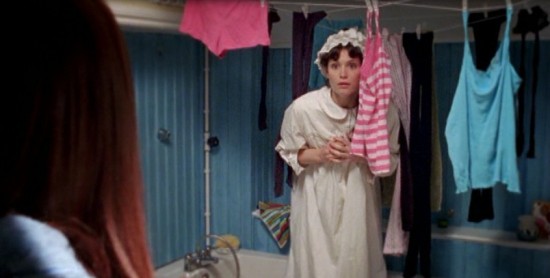
Elizabeth Bennet arrives in Amanda’s bathroom. Lost in Austen.
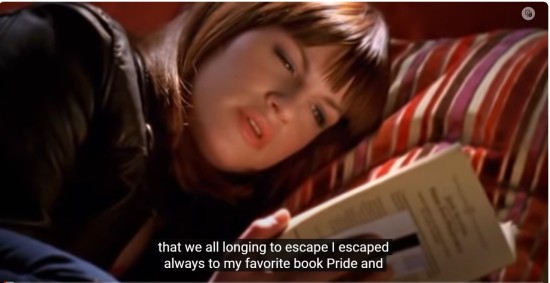
Amanda Price reads Pride and Prejudice. Lost in Austen.
Although time-travelling becomes paramount in invoking the spirit of the author, Amanda Price, unlike other Janeites, does not take part in the Jane Austen franchise. In Lost in Austen, there are no evocative items that promise to enable devotees to live as the writer might have done, no ironic artefacts or objects that allow fans to interact with the author.3 The heroine is not interested in the business of Austen that generates the plethora of Austen-themed items and web-based fanfic. Amanda even states that she is not part of Darcymania: she does not, as other Janeites do, think of Mr. Darcy as her love interest. Yet, curiously, she also takes part in the Jane Austen industry in a sequence that recalls the wet-shirt scene of the 1995 Pride and Prejudice, asking Mr. Darcy (Elliot Cowan) to reproduce Colin Firth’s swim. Coming out of the lake in his wet shirt, he is no longer Austen’s Mr. Darcy but Firth’s Darcy. In fact, Amanda claims: “I am having a bit of a strange post-modern moment.” When he asks, “is that agreeable?” she answers, “indeed.” Via this intertextual instant, the heroine thus consciously participates in the Jane Austen franchise through a reference to what is for Austen’s fans the most successful adaptation of Jane Austen’s Pride and Prejudice. Itself based on Pride and Prejudice, Lost in Austen participates in the business of Austen film adaptations and offshoots.
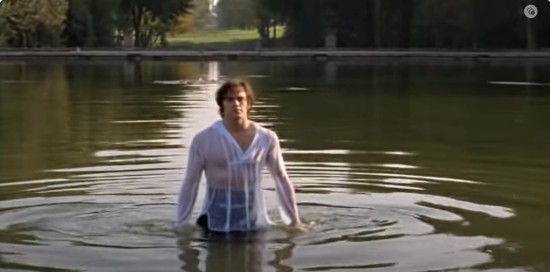
Elliot Cowan reproduces Colin Firth’s famous water scene. Lost in Austen.
Through her identification and interaction with Austen’s characters, Amanda appears as the quintessential Austen fan: she switches places with Elizabeth Bennet to become a modern-day heroine in the world of Regency England. While the character of Elizabeth is reinterpreted so that the “authentic” heroine prefers the twenty-first century and is happier in the postmodern world, Amanda becomes her own version of Lizzy, a kind of avatar. She not only invokes the spirit of Lizzy Bennet but displaces her, becoming the new heroine. She causes turmoil in Regency England, rewriting the story with significant changes. As may be expected, despite her initial statement that she is not obsessed with Mr. Darcy, Amanda Price is romantically united with Austen’s most beloved male hero. The miniseries culminates with their romantic union and seems to finish with the “happily ever after” message.
Rewriting Jane Austen’s works is common among Janeites, and the heroine of Lost in Austen is an expert at doing so. Once she time-travels to Longbourn, Amanda causes turmoil, rewriting Pride and Prejudice a great deal. According to Brett Jenkins, “the impetus for writing fanfiction often stems from a more personalized identification with characters from a particular novel, film, cartoon, game, or comic—identification, which includes a strong emotional attachment and a desire for more of the character and the storyworld” (372). This personalized identification and emotional attachment is what drives Amanda to rewrite the story and to live it as if it were real. The whole plot within the Longbourn world in the miniseries is an example of fanfiction since the Jane Austen fan Amanda Price is after all “rewriting” the story—for example, Jane Bennet’s marriage to Mr. Collins and Lydia Bennet’s elopement with Mr. Bingley. The main change takes place at the climax of the miniseries in Amanda and Mr. Darcy’s kiss, implying Amanda’s conquest of Mr. Darcy. Though the kiss is an idyllic and fantastic moment, the implicit message of Lost in Austen is that Jane Austen is not therapeutic for this Janeite, because the author’s oeuvre leads fans to a fantasy world far from reality.
Janeites in film: Austenland
According to E. M. Forster, Janeism, the true Janeite’s religion, can be defined as the idolatrous admiration for everything relating to Jane Austen and her works (279). The cult Forster describes is best represented in the character of Jane Hays in Austenland, directed by Jerusha Hess and based on Shannon Hale’s novel of the same title. Jane Hays is interested not only in Pride and Prejudice but in everything that can be somehow linked to her admired and beloved Jane Austen, from Regency antiques to cups, T-shirts, and tote bags emblazoned with “I ❤️ Mr. Darcy.” For Jane Hays, the central place of the cult is her home, especially her bedroom in which she collects her “treasures.” Like any religion, her Janeism allows her to escape from the boredom of her dull and loveless life to romantic fantasies with her idealized male hero, Mr. Darcy.
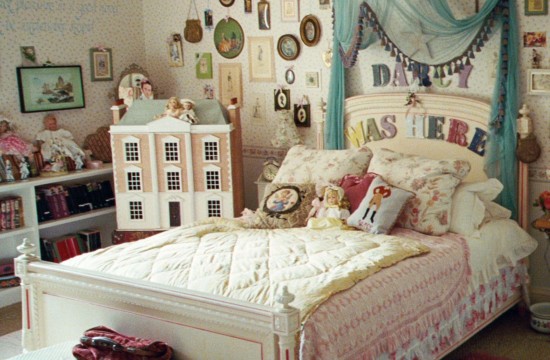
Jane Hays’s bedroom is full of Jane Austen artefacts. Austenland.
(Click here to see a larger version.)
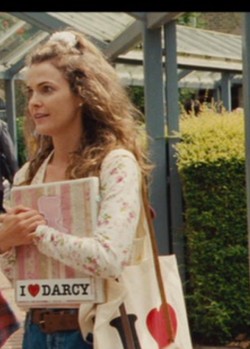
Jane Hays carries a folder with an “I ❤️ DARCY” sticker and an “I ❤️ DARCY” totebag. Austenland.
Jane’s Janeism is channeled into one of its more specific branches, Darcymania. The protagonist is obsessed with Mr. Darcy (again as played by Colin Firth) to the extent that it is destroying her love life, given that no real man can compare to the fictional hero. This Darcy-crazed Jane gathers all the Darcy-themed objects she has managed to collect, such as “I ❤️ DARCY” bumper stickers, cushions, silhouettes, tote bags, and a life-sized Colin Firth cutout in her living room. For twenty-first-century Janeites like Jane Hays, afflicted with Darcymania, Mr. Darcy and Austen in general are, Francus observes, “the source of all their romantic problems.” Jane Hays has been desperately seeking Darcy, a search that has caused only pain and endless catastrophic dates as her possible suitors can never compete with fictional Darcy.
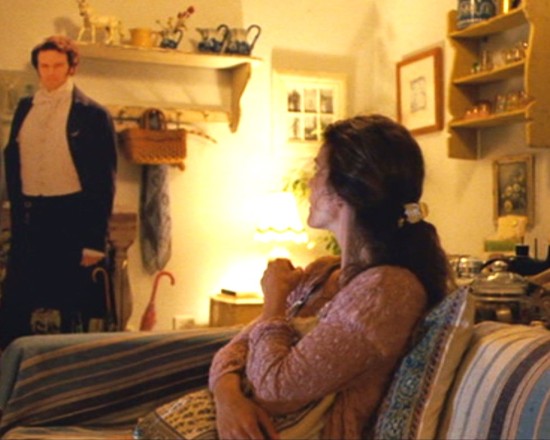
A life-sized Colin Firth cutout stands in Jane Hays’s living room. Austenland.
Austenland really stands out because, for the first time in a film, it promotes Jane Austen as commodity and takes part in what Marjorie Garber calls the “Jane Austen syndrome.” As Jen Barrows states, the “industry” of Jane Austen is a multimillion-dollar affair spanning a myriad of derivative products and services (36), and Austenland provides a powerful instance of that merchandizing. The cardboard cutout of Colin Firth in Mr. Darcy garb in the middle of Jane’s living room, the dozens of figures of Jane Austen and/or her characters, the silhouettes, the cushions of Mr. Darcy, and the endless editions of the novels highlight the marketability of Jane Austen.4
Austenland also spotlights literary tourism. Literary tourism “promises its participants an enhanced understanding of their beloved authors,” Lynch says (116), but, as Allison Thompson suggests, contemporary Janeites instead might tour not Austen sites but “stately houses that Austen never visited but that have recently served as movie sets.” Jane Hays goes not to sites connected with the historical Jane Austen (Steventon, Bath, Chawton, Winchester)5 but to Austenland, an English theme park for American fanatics, “staffed with actors and decorated with stuffed animals” (Casoulis). The brochure promises a full Austen experience, including a considerable number of Regency amenities, costumes, traditions, and even romance for every single woman visiting Austenland. Instead of starting her journey dressed in a Regency outfit, she wears an ill-fitting gown made by her sister that seems almost more Renaissance than Regency. When she arrives in Austenland, however, she is dressed according to the Regency codes, reminding us of other Janeites who participate in Regency festivals and balls, such as those that take place annually in Bath.
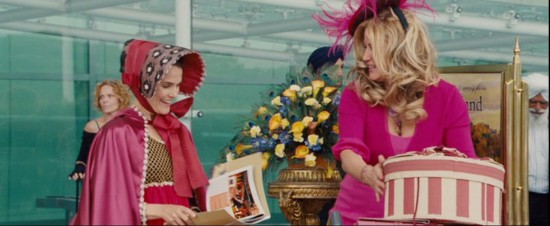
Jane Hays wears an ill-fitting gown made by her sister. Austenland.
Like Lost in Austen’s Amanda Price, Jane interacts with characters from Austen’s novels, as actors in Austenland enact scenes from Jane Austen’s works. Here too the protagonist becomes an avatar of Elizabeth Bennet. Miss Erstwhile—the name Jane Hays is given by the park’s owner—reminds the audience of Lizzy Bennet with her limited budget and her wit and intelligence. Her quick remarks at the dinner table and the inevitable battle of the sexes with Mr. Henry Nobley—a sort of blonde Mr. Darcy without sideburns—cannot but remind the audience of the well-known duo. Jane, like Lizzy, loves books and performs poorly at the piano. She is involved in a triangle. As in Pride and Prejudice, Jane Hays is prejudiced against Mr. Darcy’s counterpart, Mr. Henry Nobley, and attracted to the Wickham figure, the apparently poor, chivalrous, good-hearted Martin. As his surname indicates, Mr. Henry Nobley, the owner’s nephew, is not playing a role but, in trying not to disappoint the visitors, is outside his comfort zone. Martin is revealed as an unscrupulous trickster, an actor being paid to make Jane Hays fall in love with him.
Although Jane gets her happily-ever-after finale, she achieves it by rejecting Jane Austen and her commodification. Disenchanted by her Austenland experience, Jane returns home and disposes of all Austen-themed items—the “Darcy was here” headboard, bags, pictures, Regency-style lamps and cushions, and the rest. The movie’s close-up of Jane Hays in her bedroom reveals her disappointment with Austen and her coming to terms with “real life.” The separation from Austen’s world, paradoxically, promotes her longed-for romance—with Mr. Henry Nobley, the film’s Darcy-figure. Austenland’s ending centers on the couple Jane Hays and Mr. Henry Nobley, highlighting the similarities with Elizabeth and Darcy, even in the way they declare their love. The film argues that Jane Austen is not only not therapeutic but is the source of Jane Hays’s problem with men. Austenland’s implicit message is that the Janeite, obsessed with Jane Austen’s world and seeing only the banality of ordinary life, can only start to love and live when Jane Austen is no longer part of her life.
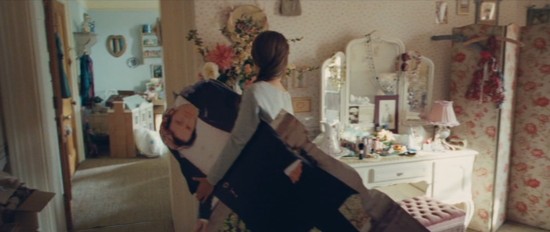
Jane Hays disposing of her Darcy paraphernalia. Austenland.
Searching for Austenites in the movies: The Rewrite
The search for an Austenite in films is more difficult. The only one I have found so far is in the romantic comedy The Rewrite, starring Hugh Grant and Marisa Tomei. The film revolves around an Academy-award-winning screenwriter Keith Michaels (Grant), who, after a chain of successive failures, agrees to teach at Binghamton University in New York. Seeking a quick comeback, he decides not to “waste” his brain on his students, spending minimal time and effort. The spoiler of this apparently ideal situation for Michaels is the Austen scholar Professor Mary Weldon (Allison Janney).
Mary Weldon is Keith Michaels’s nemesis. She is depicted, in Stephen Holden’s words, as a “severe, scowling Jane Austen scholar, tenured professor and head of the college ethics committee.” Weldon is introduced as a scholar about to publish the definite work on Jane Austen; the misogynistic Michaels claims that Jane Austen only wrote about trivialities. Weldon and Michaels are set up as opposites. While Weldon is obsessed with literature and despises cinema, Michaels adores cinema and is not very keen on literature. While Weldon values women writers such as Austen, the Brontës, and Woolf as critical to female empowerment, Michaels remarks, “I’m just a little bit tired of female empowerment.”

Prof. Mary Weldon is introduced as an Austen scholar. The Rewrite.
That issue of female empowerment links Jane Austen and Mary Weldon, the most respected teacher in the department. Since, like Austen, she is single, Weldon concentrates on her career. She is committed to her research, her job, and especially Jane Austen. Weldon has achieved overwhelming success, is respected by all her colleagues, and has fulfilled her dreams. Far from presenting a positive image of Professor Weldon, however, the film portrays this bold and independent woman negatively, stressing that her job—and, therefore, Jane Austen—is the only thing that matters to her. The department head, though publicly complimenting her work, once says that “she behaves the way she does because she is elitist, lonely, and bitter.” Thus, an Austen scholar is severely criticized for being merely an enthusiast of Austen. Unlike Amanda Price and Jane Hays, Mary Weldon has a life and job she likes—and yet, what the audience is offered is a haughty and aloof woman, a caricature of an Austen devotee.6
The Rewrite shows the Austenite as cut off from life. After their argument at the welcoming party, Michaels goes to Weldon’s office to make amends through Austen-related gifts, where he finds Weldon reprimanding a student for writing an essay on Persuasion based on opinion and intuition rather than objective academic analysis. A close-up shot of Weldon’s office centers on her collection of Jane Austen’s novels7 and Cassandra Austen’s portrait of her sister (not the prettified Victorian version). An exaggerated and unrealistic scene follows this close-up. As an apology for his behavior, Michaels presents Weldon with a collection of movies based on Austen’s works and a “What would Jane Austen do?” tote bag. To his surprise—and ours—Weldon is not only unfamiliar with the films but is even shocked by the assortment. Michaels recommends Clueless—to Weldon’s astonishment based on Emma. Weldon’s ignorance of popular culture makes her an unbelievable figure—as if it were possible as an Austen scholar to live in oblivion of Jane Austen as a cultural phenomenon.
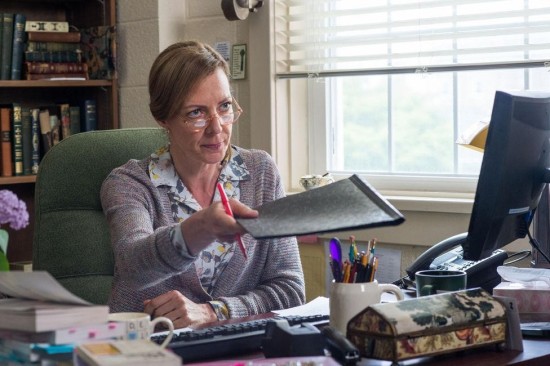
A stern Professor Weldon reprimands a student for a poor essay on Persuasion. The Rewrite.
The definition of Austenites as limited is further developed in The Rewrite through the comparison between Weldon and a male Shakespeare scholar.8 Jim Harper (played by Chris Elliot) quotes Shakespeare constantly, is always accompanied by his dog, wears a green baseball cap, and even stalks strangers like Michaels. Yet, although Harper is described as a nerd, he is depicted positively, becoming buddies with Michaels, while the Austen scholar remains isolated. In The Rewrite it is cool to be a Shakespearean devotee, whereas being an Austen scholar is harshly criticized, the misogynistic implication being that loving Jane Austen can only involve solitude and an unhappy life outside reality.

The Shakespeare scholar, in his green baseball cap, with Michaels. The Rewrite.
As can be predicted, Professor Weldon undergoes a transformation at the end of The Rewrite, changing from an Austenite into a Janeite. Although Michaels has had a sexual relationship with a student and expects to be expelled from the university, Weldon forgives that transgression. Despite her initial suspicion and contempt of Michaels, she puts aside, she claims, her “pride and prejudice.” She has relaxed (no longer an Elinor but a Marianne, she says) and now carries the “What would Jane Austen Do?” tote bag that Michaels gave her—which raises some questions. If Professor Weldon is carrying the bag, does that mean she has also watched the movies? Has she changed her mind about popular culture? Has she embraced the world of Jane Austen and commodification? The implication is that approaching Jane Austen via popular culture makes her more likeable and approachable, as if being an Austenite means boredom, loneliness, and haughtiness. As Matt Hills points out, “the categorical splitting of fan/academic here is . . . simply a philosophical or theoretical error” (2). Although crossing the line between Austenite and Janeite, scholar-fan or fan-scholar, seems easy, neither of those identities receives much respect in The Rewrite’s misogynistic world.
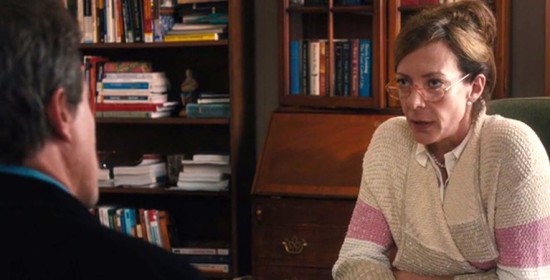
At the end of The Rewrite, a more relaxed Weldon forgives Michaels. The Rewrite.
![]() Austenland, Lost in Austen, and The Rewrite provide a clear criticism of Austen’s contemporary devotees, whether Janeites or Austenites. These acolytes of Jane Austen are addicted and obsessed readers, whose imagination has been permeated with Austen characters and who have lost track of reality. They have no romantic lives because they are always looking to Austen’s fictional models or because they have devoted their professional career to Austen and cannot see beyond her world. Though they try to fulfil their Austen fantasies, their dreams can only come true when, to some degree, they have turned away from the author. These movies suggest that Austen’s writing is no longer therapeutic, that the consumption of Jane Austen leads only to frustration.9
Austenland, Lost in Austen, and The Rewrite provide a clear criticism of Austen’s contemporary devotees, whether Janeites or Austenites. These acolytes of Jane Austen are addicted and obsessed readers, whose imagination has been permeated with Austen characters and who have lost track of reality. They have no romantic lives because they are always looking to Austen’s fictional models or because they have devoted their professional career to Austen and cannot see beyond her world. Though they try to fulfil their Austen fantasies, their dreams can only come true when, to some degree, they have turned away from the author. These movies suggest that Austen’s writing is no longer therapeutic, that the consumption of Jane Austen leads only to frustration.9
But these movies are built on a contradiction. By including allusions to the author, they not only introduce viewers to the world of Jane Austen but also participate in the Jane Austen industry. Although apparently paying tribute to Austen, this spate of movies critiques Austen fandom. They imagine Austen’s acolytes as all alike, categorizing fans within the stereotypes of social misfits and mindless consumers. For these films, Jane Austen is the cozy English lady pictured on souvenir tea towels who writes about bonneted romance—courtship or the lack of it. Just as there are many types of Austen readers, there are many versions of Jane Austen. Lost in Austen, Austenland, and The Rewrite perpetuate clichéd understanding of the author as an icon of Englishness and romance—far from what Jane Austen means to those who read and study her work.
NOTES
1See also B. C. Southam, who focuses on the tension between Janeites and anti-Janeites (the haters of Jane Austen).
2For more on Austen and the cult of celebrity see Lynch’s Janeites: Austen’s Disciples and Devotees, Claire Harman’s Jane’s Fame: How Jane Austen Conquered the World, Brownstein’s Why Jane Austen?, Marina Cano’s Jane Austen and Performance, and Looser’s The Making of Jane Austen.
3Allison Thompson distinguishes among three types of Austen’s fans: those who use evocative items, those who interact with Austen through the production of crafts, and those who use ironic objects based on Austen.
4As far back as 1891, Henry James criticized the commodification of Jane Austen by publishers and marketers “who have found their ‘dear,’ our dear, everybody’s dear Jane so infinitely to their material purpose” (62). The Jane Austen franchise has now expanded so much that there seems to be no limit to the deluge of Austen-themed items.
5The protagonist of Alexandra Potter’s Me and Mr. Darcy tours Austen sites.
6Some of the reviews refer to Prof. Weldon as a “matronly Jane Austen scholar.” The use of such an adjective underscores the depiction of gender in the film. See, for instance, Lodge.
7Weldon displays the Penguin Classics edition.
8As Deidre Lynch states, the appellation “Janeites” is all the more interesting since it is the only descriptor that alludes to the first name of an author. She even remarks that the term “Willies” (for the Shakespeare’s fans) would be hilarious but would never be considered (111).
9Some fanfiction explores the benefits and pitfalls of believing Jane Austen’s ideas to the letter. See, for instance, Beth Pattillo’s 2009 Jane Austen Ruined My Life.
